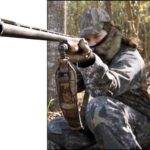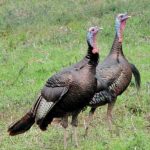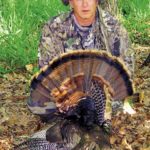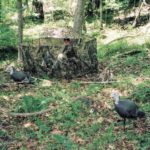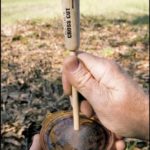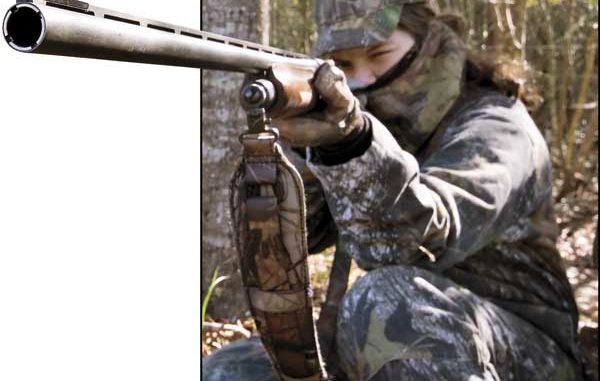
Follow these steps, and you’ll make the most of your turkey hunts on tiny tracts of land.
You don’t have to be an expert turkey hunter or have sole access to thousands of acres to kill a bird during the spring season. Many of us are forced to hunt on considerably smaller acreages. We can still get our birds, but modifying the way we hunt a bit may increase our odds. The traditional approach to turkey hunting is to use “run-and-gun tactics where the hunter actively walks all over the property calling and attempting to find a receptive gobbler.
This can be counterproductive on small acreages. The problem is, you will likely be running into and educating the birds. The birds get flushed, spooked and quickly begin to associate calling with hunters. On small properties these problems are magnified because the hunter is limited as to where he can go.
Here are some ideas and tips I have picked up talking to turkey hunters during my travels as a state game biologist and from 30 years of personal turkey hunting experience. These ideas were specifically aimed at hunting on smaller acreages (less than 1,000 acres), but most are also applicable to larger properties.
1. Minimize woods disturbance. This is one of the first things I was told by a turkey hunting great, the late John Lincecum of Grant Parish, when I started turkey hunting several decades ago. It is very important to let the woods calm down.
Do not use all-terrain-vehicles in the turkey woods prior to and during the hunting season. Do not practice calling in the woods. You do not want to educate the birds any sooner than necessary. You really want a gobbler’s first calling lesson to be his last.
Shock calling (owl/crow) is O.K.
2. Never scare the bird. This is a critical concept for all turkey hunters, but it is especially important for hunting small acreages. The more the bird is called and flushed, the harder he is going to be to kill, assuming he stays on the property at all. This is also why it is usually easier to kill a bird the opening week than it is later in the season. It is usually better to back off and try again the next day rather than scare the bird.
One of the most common problems is trying to get in too close, either to set up or put a decoy out, and getting spotted.
Another major error is lack of patience. The hunter calls a gobbler back and forth, and then the bird shuts up. The hunter thinks the bird has left, gets up, walks over the ridge and flushes it.
Closely related, on small acreages you may not want to call blindly. That is, you may find it better not to walk down the trail and yelp without first hearing a bird.
“Always be in position and ready to shoot when you make that first call,” Lincecum advised. “If you are standing in the middle of the trail and a bird suddenly and unexpectedly appears, you will have a hard time shooting it.”
A better strategy would be to blind up at certain locations before you call, and wait at least 30 minutes after your last call before moving. Frequently turkeys, especially subdominant birds and birds that have been called too much, will come in silently to your calls without gobbling. If you are constantly on the move, you will have a greater chance of spooking these birds.
3. Blinds. Consider getting or making a portable blind. It is often necessary to sit in one location for an hour or more. Midday hunts may last four to six hours.
Tom Kelly, in his classic book, The Tenth Legion, mentions the necessity of being able to shoot off-handed and in awkward positions, because the gobbler will regularly step out in an unexpected location or just appear suddenly.
A portable blind will alleviate many of these problems. A blind will allow you to get your gun up and on the bird without getting spotted.
I usually hunt with a homemade blind made out of 20 feet of camo burlap held up by 6 aluminum rods. The whole thing rolls up, and I put a sling on it for running through the woods.
If I have time I will strap one of those camo half umbrellas to the tree above to keep me out of the sun and back in a shadow. If I am feeling ambitious, I may cut leafy limbs with my small folding saw and lay them on top the umbrella and in front of the blind.
There are also a number of commercially produced blinds on the market. Most are lightweight and very serviceable. With one pop of the wrist, they instantly expand into a blind.
4. Calling. Calling is important, but not all-important. If you can cluck and yelp, you can kill a turkey. Yes, a championship turkey caller will undoubtedly kill some birds a beginner would not, but great calling is not always necessary for success. Basic calls will do the trick if used properly.
It would be helpful to have several different calls, such as a box, slate, mouth, wingbone, etc. If you mess with a bird several mornings, he may get used to a particular call. Hitting him with something that sounds different may do the trick.
Some folks call a lot and aggressively to get the bird worked up. Other hunters call less aggressively on the theory that once you yelp, he knows exactly where you are and, hopefully, will eventually come over to find you.
The hunter needs to be flexible and deal with each situation as necessary.
5. Decoys. Should you use decoys? I have killed birds I probably would not have without a decoy, and I have scared gobblers off while using a decoy that I probably would have killed without one.
Early in the season, you might consider not using a decoy if you think the gobbler is traveling with hens. As a rule, hens do not seem to like decoys.
Later in the season, when the hens are out laying eggs, decoys can be deadly at sucking a lonely gobbler in. Frequently, in a woods situation, if the gobbler is close enough to see the decoy, he is close enough to kill anyway. Remember: An awful lot of birds get spooked off by the hunter trying to put out a decoy.
6. Food plots. Turkeys like food plots to feed and display in. Clover and wheat plots are very attractive, and should be planted in the fall. Planting chufa during the spring is another option. Chufa is a real turkey magnet. All these plots make great places to set up on for midday hunts.
7. Where to hunt. If you have a piece of private property you can hunt on, great. If not, the state has a number of very productive wildlife management areas. Just call one of the regional wildlife offices, and they will be glad to direct you to the nearest area.
Now, how do you know where to go? This is not as hard as it might seem, but you need to spend some time in the woods scouting. Where you saw birds during the deer season may or may not be where they are in the spring. Turkeys frequently change ranges based upon the season.
One of a turkey’s great weaknesses is its tendency to be a creature of habit, and this can be used against it. Where have you been seeing birds? Where have you been seeing turkey tracks? Are some ridges or flats torn up with turkey scratching? Do you have a food plot with lots of turkey poop or dusting areas in it?
If you have hunted the area before you can go to areas birds have historically roosted/gobbled. Go out at daylight several days before the season opens, and fine tune exactly where they are this year. Remember not to make turkey calls during these pre-season trips, as you do not want to educate the birds.
You can try to listen for them to fly up to roost and gobble the evening before the hunt. Birds do not always gobble on the roost, and you have to be very close to hear them fly up.
To turkey hunt, you need to be at your listening location well before the first crack of dawn. Hopefully, at gobbling time or first light, you will hear one or more birds gobble on the roost.
Then move. Try to get to within 200 yards or so. If you are in the hills, try to get uphill from the bird and on the same ridge. Do not get spotted. When in doubt, back off and set up farther away. Set up your portable blind or sit by a big tree if possible.
Now, let us go through several different hunt scenarios:
Scenario 1: The way it is supposed to go (but seldom does). The bird has been gobbling on the roost. You give a soft yelp (tree yelp), and he immediately gobbles back. Great, he knows you are there.
The sky is lightening up pretty good, but it is not quite fly-down time yet. You give a yelp. He gobbles back. Wait a couple minutes, then yelp again. He gobbles again.
If the gobbler has other hens nearby, you will probably have to call more aggressively, and it still may not help. If the gobbler does not have hens in attendance, you may want to quit calling. Hopefully, when he flies down he will come looking for you. This may take an hour, even more. Be patient. Bang! End of hunt.
Another variation of Scenario 1 is: He flies down and gobbles. You yelp, and he gobbles back. Every few minutes, you yelp and he gobbles but does not seem to be coming in.
What they will frequently do is strut back and forth, gobbling and waiting for the hen to come to them. This is the way it is supposed to work in the turkey world. In a situation like this, an option would be to not call any more. Hopefully, the bird will eventually get lonely and come looking for you. Wait at least an hour after you hear the last gobble. Do not go over and see where he was gobbling at until several hours later. If he just quits gobbling, be patient and ready.
Scenario 2: The way it usually goes. The bird flies down and is walking away from you gobbling. Rotten bird. If you know the ground and are fleet-of-foot, you can try to “loop him,” if the terrain permits. This means, by some other route, run and get in front of him and set up. In the hills, this is frequently not possible.
Remember not to let the bird spot you. You would probably be better off to come back the next day, and set up in direction he wants to go. If you do not disturb a turkey, it will frequently roost in the same general area.
Scenario 3: The bird gobbles once or twice on the roost. You call and he shuts up. This is not a good situation. You do not know where he is or where he is going. You have little choice other than to retreat immediately or sit for an hour. Do not go to the suspected roost area until midday. He may just be sitting there.
Midday hunts
O.K., you made your hunt at first light and, for whatever reason, failed to score. Now, what do you do?
On small acreages, running and gunning may not be much of an option.
Let us think about this from another angle. A turkey does not just stand in one place all day. The famous turkey researcher Lovett Williams says a turkey may walk 4 miles a day. They cover a great deal of ground.
Either we can chase the bird all over the property trying to get close enough for him to hear us, greatly increasing the chances we will scare him, or we can wait for him to come to us.
Blind up and sit there. It is just like deer hunting, only you don’t have to worry about getting winded. The trick is to know where the feeding areas and travel corridors are. Set up and make a light yelp or cluck every 30 minutes or so, just enough to let a bird moving through the area know there is a hen there.
Then it all boils down to patience and hours spent in the woods. I, personally, sit on a boat cushion and read paperback books, but I am always listening. I hunt in fairly heavily hunted areas, and have discovered once a bird has been fooled with a bit, he frequently will come in without gobbling at all. Probably a quarter of the birds I have killed I did not know were even coming until I heard the leaves crunching as they walked up.
I carry my lunch and coffee bottle, and make a day of it. It is a scientific fact you will kill lots more turkeys in the woods than you will at the camp or eating lunch by the truck. It is a pretty time of the year to be out in the woods.
Evening hunts
Where did the gobbler roost that morning? Can you set up and catch him coming back to the roost? Fly up time is usually not until right at dark. I, personally, do not call that aggressively in the evening. I really am just hoping to catch a bird feeding through or get an idea where they will be the next morning.
Perhaps most importantly, remember that persistence pays. It is a matter of statistics. Some time ago, a famous baseball player was told by one of his fans how lucky he was after making a spectacular play.
“Yeah, I am lucky,” the player responded, “and you know, the more I practice, the luckier I get.”
Turkey hunting is the same way. The more hours you spend in the woods, the luckier you are going to be.
